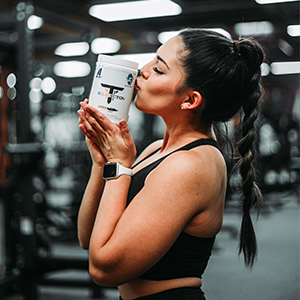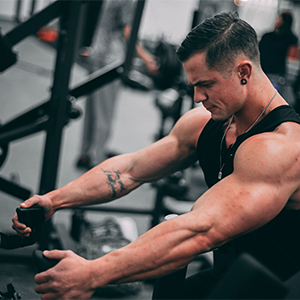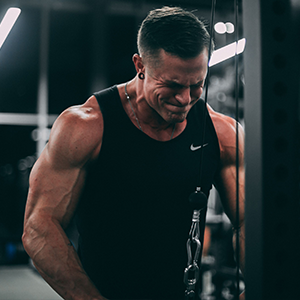
Sculpting Six-Pack Abs
Achieving six-pack abs is a goal that many fitness enthusiasts strive for but only some manage to achieve. The secret to those chiselled abs isn't just hours spent doing crunches or cardio; it's largely about diet.
A low-carb, high-protein diet is one of the most effective dietary strategies for revealing your abdominal muscles. This approach promotes fat loss while preserving muscle mass, helping you achieve that lean, defined look. In this article, we'll delve into why this diet works and how it impacts your body and provide practical tips for implementation. We'll also reference insights from fitness influencers and offer detailed guidelines on protein intake.
Why Low-Carb, High-Protein Diets Work
The journey to six-pack abs involves reducing body fat to reveal the muscles underneath. Here's why a low-carb, high-protein diet excels in this area:
Insulin and Fat Storage
Carbohydrates, especially refined ones like sugars and white flour products, cause spikes in blood sugar levels. This triggers a surge in insulin production, a hormone responsible for regulating blood sugar by facilitating glucose uptake by cells.
However, insulin also promotes fat storage. When insulin levels are consistently high, your body remains in a fat-storage mode, making it difficult to lose belly fat.
Reducing your carbohydrate intake minimizes insulin spikes, thus helping to prevent fat storage and encouraging fat loss instead.
Enhanced Fat Burning
When you cut down on carbs, your body is forced to use fat as its primary energy source. This metabolic state, known as ketosis, significantly enhances fat burning, particularly in stubborn areas like the abdomen.
In ketosis, the liver converts fat into ketones, which serve as an alternative energy source for the body. This process not only helps in reducing overall body fat but also targets the visceral fat around your midsection.
Muscle Preservation
Maintaining muscle mass is crucial when trying to achieve a toned, defined look. A high protein intake supports muscle maintenance and growth. Protein provides the necessary amino acids for muscle repair and synthesis.
Moreover, muscle mass increases your resting metabolic rate, meaning you burn more calories even when you're not active. This combination of fat loss and muscle preservation is key to unveiling six-pack abs.
How Much Protein Do You Need?
To maximize muscle preservation and promote fat loss, consuming an adequate amount of protein is essential.
Renowned fitness YouTuber Jeff Nippard emphasizes the importance of protein intake, recommending about 1 gram of protein per pound of body weight for individuals aiming to achieve six-pack abs.
For instance, if you weigh 150 pounds, you should aim for 150 grams of protein per day. This intake ensures your body has sufficient amino acids to support muscle repair and growth, even in a calorie deficit.
Choosing the Right Protein Source
Not all proteins are created equal. High-quality, low-calorie whey protein isolates are an excellent choice for supplementing your protein intake.
Supplements like Atomic Fuel X30 provide a high amount of protein with minimal carbohydrates and fats, making it easier to meet your protein needs without excess calorie intake.
Benefits of Whey Protein Isolate
1. High Bioavailability:
Whey protein isolate is quickly absorbed by the body, making it an ideal post-workout supplement to support muscle recovery.
2. Low in Carbs and Fats:
It provides a high protein content without the extra calories from carbs and fats.
3. Convenience:
Whey protein isolates are convenient and versatile, easily mixed into shakes, smoothies, or even incorporated into recipes.
Practical Tips for Implementing a Low-Carb, High-Protein Diet
1. Plan Your Meals:
Structure your meals around protein-rich foods such as lean meats, poultry, fish, eggs, and dairy. Supplement with high-quality protein powders to meet your daily requirements.
2. Monitor Carbohydrate Intake:
Limit your intake of refined carbs and focus on complex carbohydrates from vegetables, nuts, and seeds.
3. Healthy Fats:
Include healthy fats like avocados, olive oil, and nuts to support overall health and satiety.
4. Stay Hydrated:
Adequate hydration is crucial for metabolism and overall health.
5. Track Your Progress:
Use a food diary or app to monitor your macronutrient intake and ensure you’re staying on track.
Combining Diet with Exercise
While diet is critical, pairing it with the right exercise regimen will accelerate your progress. Focus on a mix of resistance training and high-intensity interval training (HIIT) to maximize fat loss and muscle retention.
Resistance Training:
Aim to lift weights at least 3-4 times per week. Focus on compound movements like squats, deadlifts, bench presses, and pull-ups. These exercises work multiple muscle groups and promote muscle growth and fat burning.
HIIT:
Include HIIT workouts 2-3 times per week. These sessions involve short bursts of intense exercise followed by rest periods, helping to burn calories and fat effectively without compromising muscle mass.
Monitoring Your Progress
To ensure you're on the right track, monitor your progress regularly. Use a combination of methods such as:
Body Measurements: Track changes in your waist, hips, and other key areas.
Progress Photos: Take photos at regular intervals to visually document your transformation.
Body Fat Percentage: Use tools like calipers or body fat scales to measure your body fat percentage.
Performance Metrics: Keep a workout log to track your strength and endurance improvements.
Common Pitfalls to Avoid
When adopting a low-carb, high-protein diet, be mindful of common mistakes:
Not Eating Enough Protein: Ensure you meet your protein targets consistently.
Overeating Fat: While fats are necessary, overeating them can hinder fat loss.
Skipping Vegetables: Vegetables provide essential vitamins, minerals, and fiber. Include low-carb options like leafy greens, broccoli, and peppers.
Conclusion
A low-carb, high-protein diet is highly effective for achieving six-pack abs. By minimizing insulin spikes and maximizing protein intake, you can promote fat loss and preserve muscle mass. Coupled with a structured exercise regimen and consistent monitoring, this diet can help you achieve your fitness goals.
Remember, supplements like Atomic Fuel X30 whey protein isolate can support your protein intake without adding unnecessary carbs and fats. Check it out to help you stay on track with your nutrition.
Stay dedicated, follow the principles outlined in this article, and you’ll be on your way to revealing those six-pack abs!




Leave a comment